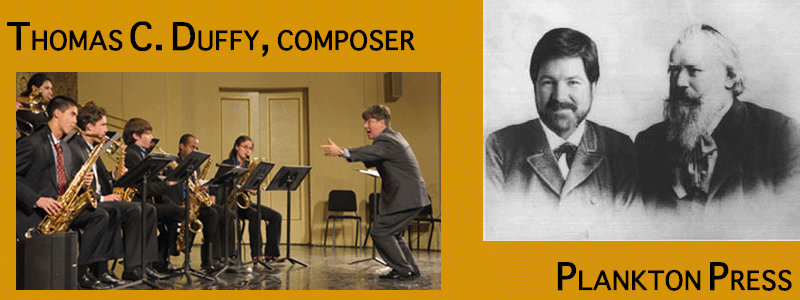Three Places in New Haven
Concerto for Marimba and Wind Ensemble
(For Robert Van Sice)
(2001) c. 20:00
I. Castle in the Sky (Rollo Reads a Book)
II. The Long Wharf (Rollo Sails Away)
III. City Band March (Rollo Gets A Job)
Charles Ives spent four years on the Yale campus in New Haven, CT, from 1894-1898. Many of the places that he frequented are still intact. Each movement of this concerto addresses one particular place in New Haven.Each is frequented or visited by Rollo, Ives’ fictional character of lowest-common denominator aesthetic sophistication and taste.
I. Castle in the Sky (Rollo Reads a Book)
Castle in the Sky. Yale’s library was built by stone masons and is set in a gothic style. The workers took left over materials and, instead of constructing ventilation boxes on the roof in the traditional square-box fashion, covered the air vents with a miniature medieval castle, complete with flying buttresses and cobbled walls. From some distance, one can see this castle, perched curiously on the top of a ten-story building. It floats above Yale’s Cross Campus green-space, where students go to sit on the grass after studying.
In this movement, one hears the opening bustle of students scurrying to class. The motives are made of Charles Ives’ name through the ancient technique of soggeto cavato (carved subject). C = c, H = b, A = a, R = re = d, L = la = a, E = e, S = Eb, and I = ti = b. Thus, the Ives motive is c, b, a, d, a, e, eb, b. The scurrying fades to reveal the quiet contemplative sounds of students at work (Yale’s alma mater, Bright College Years [Die Wacht Am Rhein). Students run for the library before it closes and one hears the clock tower sounding the warning for doors to close. Once inside, students set to work and the solo marimba presents a 4-part hymn.
But Rollo has a very short attention span. As the monotony of reading begins to affect him, he daydreams. First the sounds of student life outside begin to invade his consciousness. In fact, he wonders why he studies at all – what’s the use? (The metaphysical question is presented by the trumpet – in the style of a question that ‘may never be answered.’) Eventually, Rollo fantasizes that a military maneuver is taking place in the castle in the sky- one hears the sounds of percussion marching troops here and there. The solo marimba attempts to "question" Rollo’s daydream, and things end with neither an answer to the question nor a firm sense of whether the dream is real or the reality a dream.
II. The Long Wharf (Rollo Sails Away)
The Long Wharf. The Long Wharf extended far out into the shallow New Haven harbor, and had for many many years been the place where ships loaded and unloaded their produce and other goods. This was the harbor into which the British sailed during the Revolutionary War (and a few patriots fired a cannon at the British ships. Their aim was so poor that the British reported that they conquered New Haven unchallenged!). The harbor also is the home of Savin Rock, for years New Haven’s miniature version of Coney Island. Now the New Haven Green is far inland from the harbor’s water, but before a century of land fill, the church in which Ives played the organ was very close to the shore itself. Close enough for the sounds of the church’s bells to be heard on the water.
Rollo opts to spend Sunday morning not in church, but sailing on the harbor. The sun comes up on the peaceful waters of the harbor and Rollo floats about in a state of blissful detachment. Rollo dozes on the boat, here and there one (and perhaps he) hears the sounds of the church service – the hymn that wafts out over the harbor contains a message – it is Wachet Auf (Sleepers Wake!).
III. City Band March (Rollo Gets A Job)
City Band March is homage paid to Charles Ives' Country Band March. This march follows the form of its' country cousin, including a da capo exposition, and a "coda" in which things become complicated.
The city of New Haven was home to Eli Whitney, the innovator who brought the concept of mass production to life. During Ives' time in New Haven, industry boomed and citizens enjoyed a fine mass transportation system, founded on a network of trains and trolley cars. This music present the sounds of a city at work, busily producing "things;" some of metal, some needing to be stamped out, and some requiring much repetitive attention.
Rollo works in a factory, and dreams throughout the workday of the pleasant train ride home to the country. He himself is a "mass product:" he dresses like everyone else, he rides the train in like everyone else, he repeats the same task all day like everyone else, and at day's end, he joins the long trudging line of automatons as the "masses" move in synchronicity, coming and going to their assigned jobs (here their robot-like cadence, two quarter-notes, two eighth-notes, and one quarter note!).
Does the piece end with Rollo boarding a train that increasingly speeds him home, or is it his imagination - the acceleration representing his increasing desperation to be out of the factory and on his own? You decide.
Commissioned by:
The University of Akron, Robert Jorgensen *
State University of New York at Fredonia, Paula Holcomb
University of Southern Mississippi, Thomas Frascillo
Michigan State University, John Whitwell
Bowling Green State University

